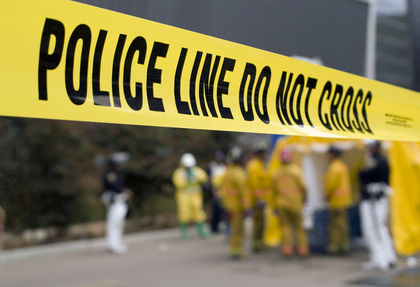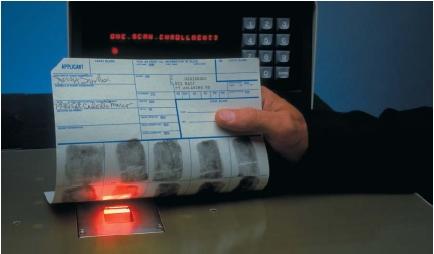Forensic science

Forensic science is the application of science to matters of law. A basic principle of forensic science is that a criminal always brings something to the scene of a crime that he or she leaves behind. The "something" left behind is the evidence that detectives and criminalists (people who make use of science to solve crimes) look for. It might be fingerprints, footprints, teeth marks, blood, semen, hair, fibers, broken glass, a knife or gun, or a bullet. It also might be something less tangible such as the nature of the wounds or bruises left on a victim's body, which might indicate the nature of the weapon or the method of assault. Careful analysis of evidence left at the scene of a crime often can be used in establishing the guilt or innocence of someone on trial.
Fingerprints
Although fingerprints have been used by crime investigators for more than a century, they remain one of the most sought after pieces of evidence. All human beings are born with a characteristic set of ridges on their fingertips. The ridges, which are rich in sweat pores, form a pattern that remains fixed for life. Even if the skin is removed, the same pattern will be evident when the skin regenerates. Some of the typical patterns found in fingerprints are arches, loops, and whorls.
Oils from sweat glands collect on these ridges. When we touch something, a small amount of the oils and other materials on our fingers are left on the surface of the object we touched. The pattern left by these substances, which collect along the ridges on our fingers, make up the fingerprints that police look for at the scene of a crime. Fingerprints collected as evidence can be compared with fingerprints on file or taken from a suspect. The Federal Bureau of Investigation (FBI) maintains a fingerprint library with patterns taken from more than 10 percent of the entire United States population.

Fingerprints are not the only incriminating patterns that a criminal may leave behind. Lip prints are frequently found on glasses. Footprints and the soil left on the print may match those found in a search of an accused person's premises. Tire tracks, bite marks, toe prints, and prints left by bare feet also may provide useful evidence. In cases where identifying a victim is difficult because of tissue decomposition or death caused by explosions or extremely forceful collisions, a victim's teeth may be used for comparison with dental records.
Genetic fingerprinting
The nuclei within our cells contain coiled, threadlike bodies called chromosomes. Chromosomes are made of deoxyribonucleic acid (DNA). DNA carries the "blueprint" (genes) that directs the growth, maintenance, and activities that go on within our bodies.
Although certain large strands of DNA are the same in all of us, no two people have exactly the same DNA (except for identical twins). It is these unique strands of DNA that are used by forensic scientists to establish a characteristic pattern—the so-called genetic fingerprint. Because different people have different DNA, the prints obtained from different people will vary considerably; however, two samples from the same person will be identical. If there is a match between DNA extracted from semen found on the body of a rape victim and the DNA obtained from a rape suspect's blood, the match is very convincing evidence and may well lead to a conviction or possibly a confession.
Other evidence used in forensic science
Long before DNA was recognized as the "ink" in the blueprints of life, blood samples were collected and analyzed in crime labs. The evidence available through blood typing is not as convincing as genetic fingerprinting, but it can readily prove innocence or increase the probability of a defendant being guilty. All humans belong to one of four blood groups: A, B, AB, or O. If a person accused of a homicide has type AB blood and it matches the type found at the crime scene, the evidence for guilt is more convincing than if a match were found for type O blood.
Bullets and the remains of tools can be used as incriminating evidence. When a bullet is fired, it moves along a spiral groove in the gun barrel. It is this groove that makes the bullet spin so that it will follow a straight path much like that of a spiraling football. The markings on a bullet made by the groove are unique to each gun. Similarly, tool marks, which are often left by burglars who pry open doors or windows, can serve as useful evidence if comparisons can be made with tools associated with a person accused of the crime. Particularly incriminating are jigsaw matches—pieces of a tool left behind that can be shown to match pieces missing from a tool in the possession of the accused.
Autopsies
An autopsy can often establish the cause and approximate time of death. Cuts, scrapes, punctures, and rope marks may help to establish the cause of death. A drowning victim will have soggy lungs, water in the stomach, and blood diluted with water in the left side of the heart. A person who was not breathing when he or she entered the water will have undiluted blood in the heart. Bodies examined shortly after the time of death may have stiff jaws and limbs. Such stiffness, or rigor mortis, is evident about ten hours after death, but disappears after about a day when the tissues begin to decay at normal temperatures. Each case is different, of course, and a skillful coroner can often discover evidence that the killer never suspected he or she had left behind.
[ See also Nucleic acid ]
Sincerley Kam
Also it is possible to tell from Forensic knot analysis if the suspect might be left or right handed?
Thanks
Berdine
Thanks
Jamila